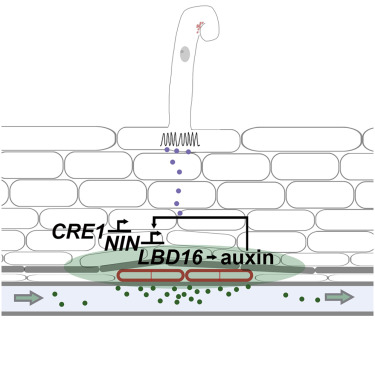Current Biology ( IF 8.1 ) Pub Date : 2019-09-19 , DOI: 10.1016/j.cub.2019.09.005 Katharina Schiessl 1 , Jodi L S Lilley 2 , Tak Lee 3 , Ioannis Tamvakis 1 , Wouter Kohlen 4 , Paul C Bailey 5 , Aaron Thomas 2 , Jakub Luptak 2 , Karunakaran Ramakrishnan 2 , Matthew D Carpenter 2 , Kirankumar S Mysore 6 , Jiangqi Wen 6 , Sebastian Ahnert 3 , Veronica A Grieneisen 2 , Giles E D Oldroyd 1

|
To overcome nitrogen deficiencies in the soil, legumes enter symbioses with rhizobial bacteria that convert atmospheric nitrogen into ammonium. Rhizobia are accommodated as endosymbionts within lateral root organs called nodules that initiate from the inner layers of Medicago truncatula roots in response to rhizobial perception. In contrast, lateral roots emerge from predefined founder cells as an adaptive response to environmental stimuli, including water and nutrient availability. CYTOKININ RESPONSE 1 (CRE1)-mediated signaling in the pericycle and in the cortex is necessary and sufficient for nodulation, whereas cytokinin is antagonistic to lateral root development, with cre1 showing increased lateral root emergence and decreased nodulation. To better understand the relatedness between nodule and lateral root development, we undertook a comparative analysis of these two root developmental programs. Here, we demonstrate that despite differential induction, lateral roots and nodules share overlapping developmental programs, with mutants in LOB-DOMAIN PROTEIN 16 (LBD16) showing equivalent defects in nodule and lateral root initiation. The cytokinin-inducible transcription factor NODULE INCEPTION (NIN) allows induction of this program during nodulation through activation of LBD16 that promotes auxin biosynthesis via transcriptional induction of STYLISH (STY) and YUCCAs (YUC). We conclude that cytokinin facilitates local auxin accumulation through NIN promotion of LBD16, which activates a nodule developmental program overlapping with that induced during lateral root initiation.
中文翻译:

结节起始招募侧根发育计划以实现蒺藜苜蓿的共生结节器官发生。
为了克服土壤中的氮缺乏,豆类与根瘤菌共生,将大气中的氮转化为铵。根瘤菌作为内共生体容纳在称为根瘤的侧根器官内,该根瘤从蒺藜苜蓿根的内层开始,响应根瘤菌的感知。相比之下,侧根从预先确定的创始人细胞中出现,作为对环境刺激(包括水和养分可用性)的适应性反应。中柱鞘和皮层中的细胞分裂素反应 1 ( CRE1 ) 介导的信号对于结瘤来说是必要且充分的,而细胞分裂素对侧根发育具有拮抗作用, cre1显示侧根出现增加和结瘤减少。为了更好地了解根瘤和侧根发育之间的相关性,我们对这两个根发育方案进行了比较分析。在这里,我们证明,尽管存在差异诱导,但侧根和根瘤具有重叠的发育程序, LOB 域蛋白 16 ( LBD16 ) 中的突变体在根瘤和侧根起始方面显示出相同的缺陷。细胞分裂素诱导转录因子NODULE INCEPTION ( NIN ) 允许在结瘤过程中通过激活LBD16来诱导该程序,LBD16 通过STYLISH ( STY ) 和YUCCA ( YUC ) 的转录诱导促进生长素生物合成。 我们得出结论,细胞分裂素通过NIN促进LBD16促进局部生长素积累,从而激活与侧根萌生期间诱导的根瘤发育程序重叠的根瘤发育程序。


















































 京公网安备 11010802027423号
京公网安备 11010802027423号